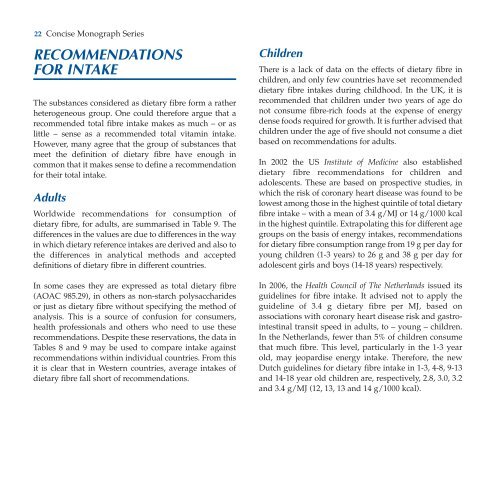Dietary Fibre - ILSI Argentina
Dietary Fibre - ILSI Argentina
Dietary Fibre - ILSI Argentina
Create successful ePaper yourself
Turn your PDF publications into a flip-book with our unique Google optimized e-Paper software.
22 Concise Monograph Series<br />
RECOMMENDATIONS<br />
FOR INTAKE<br />
The substances considered as dietary fibre form a rather<br />
heterogeneous group. One could therefore argue that a<br />
recommended total fibre intake makes as much – or as<br />
little – sense as a recommended total vitamin intake.<br />
However, many agree that the group of substances that<br />
meet the definition of dietary fibre have enough in<br />
common that it makes sense to define a recommendation<br />
for their total intake.<br />
Adults<br />
Worldwide recommendations for consumption of<br />
dietary fibre, for adults, are summarised in Table 9. The<br />
differences in the values are due to differences in the way<br />
in which dietary reference intakes are derived and also to<br />
the differences in analytical methods and accepted<br />
definitions of dietary fibre in different countries.<br />
In some cases they are expressed as total dietary fibre<br />
(AOAC 985.29), in others as non-starch polysaccharides<br />
or just as dietary fibre without specifying the method of<br />
analysis. This is a source of confusion for consumers,<br />
health professionals and others who need to use these<br />
recommendations. Despite these reservations, the data in<br />
Tables 8 and 9 may be used to compare intake against<br />
recommendations within individual countries. From this<br />
it is clear that in Western countries, average intakes of<br />
dietary fibre fall short of recommendations.<br />
Children<br />
There is a lack of data on the effects of dietary fibre in<br />
children, and only few countries have set recommended<br />
dietary fibre intakes during childhood. In the UK, it is<br />
recommended that children under two years of age do<br />
not consume fibre-rich foods at the expense of energy<br />
dense foods required for growth. It is further advised that<br />
children under the age of five should not consume a diet<br />
based on recommendations for adults.<br />
In 2002 the US Institute of Medicine also established<br />
dietary fibre recommendations for children and<br />
adolescents. These are based on prospective studies, in<br />
which the risk of coronary heart disease was found to be<br />
lowest among those in the highest quintile of total dietary<br />
fibre intake – with a mean of 3.4 g/MJ or 14 g/1000 kcal<br />
in the highest quintile. Extrapolating this for different age<br />
groups on the basis of energy intakes, recommendations<br />
for dietary fibre consumption range from 19 g per day for<br />
young children (1-3 years) to 26 g and 38 g per day for<br />
adolescent girls and boys (14-18 years) respectively.<br />
In 2006, the Health Council of The Netherlands issued its<br />
guidelines for fibre intake. It advised not to apply the<br />
guideline of 3.4 g dietary fibre per MJ, based on<br />
associations with coronary heart disease risk and gastrointestinal<br />
transit speed in adults, to – young – children.<br />
In the Netherlands, fewer than 5% of children consume<br />
that much fibre. This level, particularly in the 1-3 year<br />
old, may jeopardise energy intake. Therefore, the new<br />
Dutch guidelines for dietary fibre intake in 1-3, 4-8, 9-13<br />
and 14-18 year old children are, respectively, 2.8, 3.0, 3.2<br />
and 3.4 g/MJ (12, 13, 13 and 14 g/1000 kcal).

















